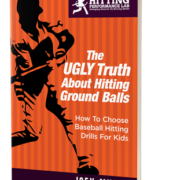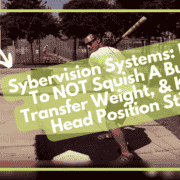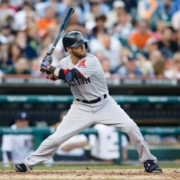Elevate, Square Up, And Hit More Line Drives Instead Of Hitting Too Many Ground Balls In Baseball & Softball (Slow Pitch Too!) | STOP Chopping, Striking Top Half Of Ball, & Grounding Out To Shortstop
Learn how to elevate, square up, and hit more line drives instead of hitting too many ground balls in baseball and softball. This works for slow pitch too! Discover how to STOP chopping, hitting top half of the ball, and ground out to shortstop.
See How Easily You Can Stop Hitting Ground-balls
Yes, I’m releasing ANOTHER book!!
AND YES, I’VE BEEN PULLING ALL-NIGHTERS, DRINKING LOTS AND LOTS OF CAFFEINE, AND LISTENING TO LOTS AND LOTS OF METALLICA TO WRITE THREE BOOKS IN 3 MONTHS!!
Kidding! 😀
I’m not that much of a savage,
But what I have for you today is the Conclusion to my latest book, which is smaller in size – about 60-something pages, and is a re-publishing of my most popular Ground-ball RANT blog post I wrote the beginning of 2016. This post achieved over 5,400 Likes on Facebook! 😀 (UPDATE: now this was before my Facebook “Like” website plugin broke, and I had to get a new one which erased all those wonderful Likes!!)
I’ll share the Conclusion to the new book shortly,
Most of you probably didn’t miss the Ground-ball RANT, so the purpose of this book and post are a little different…
SCIENCE-BASED TRAINING:
Improve your hitting strategy dramatically by applying human movement principles.
Learn not only how and what to train but also the science behind the methods.
What I want for you to do is get this book and give it away as a gift. Ideally to a coach who teaches their hitters to produce a lot of “worm-burners”, but one who may also be open to being persuaded from that unfounded malarkey.
You see, this subject has become somewhat of a movement on social media – if you haven’t noticed. CLICK the following link for a fantastic breakdown post from Dan Farnsworth at the Hardball Times titled, “Ground Balls: A Hitter’s Best Friend?”
Now, back to The UGLY Truth book…
On sale, The UGLY Truth paperback will be $9.95, and the Kindle version will be $2.99. And by the way, you don’t have to own a Kindle to read a “Kindle-version” ebook. Just download the Kindle app on any mobile device, and BOOYA! You can access it.
Do you have a High School coach in mind that could benefit from this information? Or perhaps a Little League coach? Just recommend coach download the free ebook within those 5 days. They have nothing to lose! It would be to YOUR kid’s best interest 😉
Okay, so now I want to share the Conclusion to the book (which by the way, wasn’t in my original Ground-Ball RANT)…
A reader recently emailed me that his son, although having some success before, has switched over to “my stuff”. Well, switch overs aren’t always smooth, and his son is hitting more ground-balls, so I suggested the following tips to STOP hitting ground-balls…
Enter the Conclusion to my new book now on sale at Amazon (with Kindle version free for a short period of time), The Ugly Truth About Hitting Ground-Balls: How To Choose Baseball Hitting Drills For Kids…
—–
Conclusion
I have a treat for you…
You may be thinking what I teach my hitters to do since I don’t want them hitting ground-balls. I very much agree with the Backspin Tee guys’ motto of ‘On Path of the Pitch, Bottom Half of the Ball’. But how do you put that into practice?
There are five things I look for in a swing to get the barrel on the plane of the pitch longer, so hitters can hit more consistent line drives:
- Front knee action,
- Back knee action,
- Back foot action,
- Barrel early on plane, and
- Barrel late on plane.
Front Knee Action
There are six benefits to landing with a bent front leg:
- Engaging springy fascia in the legs,
- Pitch adaptability to off speed pitches,
- Shrinking the strike zone,
- Using Ground Reaction Forces,
- Getting eyes closer to lower pitches in the zone, and
- How humans change directions and planes of motion.
We’re not going through all six, but I wanted to highlight the last one…
Please do a YouTube search for: “armanti edwards route tree session“, and pay attention to how Armanti Edwards and other NFL wide receivers change direction while doing a “Route Tree Session” with trainer Gari Scott…
Watch them run these routes from a big picture point of view. In other words, not looking for any specific arm or leg angles. Watch them ‘get lower’ when changing directions, or cutting. They land on a bent plant leg, then push off the same leg, extending it, to accelerate again.

Three main planes of motion. Photo courtesy: goldsgymwebsterny.wordpress.com
There are three main human planes of motion:
- Saggital (front to back motion) – divides the body into right and left halves
- Frontal (a.k.a. side to side motion) – any vertical plane that divides the body into ventral and dorsal (belly and back), and
- Transverse (a.k.a. twisting motion) – is an imaginary plane that divides the body into superior and inferior parts. It is perpendicular to the coronal and sagittal planes.
In changing from one plane of motion to the other, to be effective, there MUST be a ‘getting shorter’ of the body’s stature, as the athlete plants and pushes off the ground to change directions.
The wide receivers from the video are changing from the Sagittal (front to back) to Frontal (side to side) Planes. While a hitter changes from the Frontal (side to side) to Transverse (twisting) Planes.
In other words, just like an NFL wide receiver goes from a bent plant leg to straight at push off, a hitter MUST go from a bent landing leg, to a straight leg at ‘push off’.
Please CLICK the following link to see the other six benefits: http://gohpl.com/whybentfrontknee
Back Knee Action
Back knee angle during the Final Turn does have a significant impact on ball flight. More bend equals more airtime for the ball. I’ve seen Little Leaguers to Pro hitters straightening out their back legs during the Final Turn. And they often wonder why they aren’t able to drive the ball. Here’s why…
Homer Kelly, an aeronautical engineer for Boeing during the Great Depression, said this about knee bend in his book The Golfing Machine:
“The slant is up in the direction of a straightened Knee. The slant of the Hips affects the degree of the Hip Turn. Actually, the primary function of Knee Action – as with Waist Bend – is to maintain a motionless Head during the Stroke.”
Homer Kelly’s statement has as much to do with hitting as it does with the golf swing! During the Final Turn, a hitter like Adrian Beltre uses his flexed back knee (and straightened front one) to slant his pelvis up towards the downward traveling pitch, and as a result, keeps his head motionless during the Final Turn. Early head movement, pre-stride landing, is okay. Late head movement is not.
Think of the back leg angle as angling your body like a “ramp”. CLICK HERE for a great drill for getting hitters at a better “ramp” angle.
In addition, please CLICK the following link to see what happened with a swing experiment where I tested a bent versus straight back knee during the Final Turn: http://bit.ly/whybentbackknee
Back Foot Action
I did another swing experiment looking at the difference in bat speed at impact between ‘squishing the bug’ with the back foot and not squishing the bug…basically letting the back foot skip.
What was the results of the 200 swing experiment?
- +8-mph difference in average Impact Bat Speed, siding on “Skipping Back Foot”,
- +3-mph difference in average Hand Speed Max, siding on “Skipping Back Foot”,,
- -0.019 difference in average Time To Impact, siding on “Skipping Back Foot”, and
- +4-degree difference in average Attack Angle, siding on “Skipping Back Foot”
What does this mean? That ‘squishing the bug’ is an inferior hitting mechanic. Not ALL elite hitters “skip” the back foot, but most do “un-weight” it. I just like teaching my hitters a minimal skip to make sure they’re shifting center mass into impact, behind the front leg. I read somewhere that Bryce Harper shifts 150% of his body-weight into impact (skipping his back foot), whereas if he just “squished the bug”, he’d only shift 75% of it. That’s a HUGE difference!
Please CLICK the following link to read about the whole swing experiment: http://gohpl.com/whybackfootaction
Barrel Early on Plane
I recently did a video blog post case study featuring one of my 15 year old baseball players Liam titled, “Taking The Headache Out Of Teaching Barrel Path”. We used the Ropebat to change his “Verizon check mark” barrel path into a “Nike Swoosh” sign.
Why one over the other? I want my hitters to build proper bat lag into their swing, or an early barrel on the plane of the pitch. This helps the hitter barrel the ball more often when their timing may be late.
What’s amazing about Liam’s transformation was that:
- It only took ten days,
- It took two total 30-minute sessions (beginning of session three was when the AFTER video was taken), and
- Liam only had access to the Ropebat during our sessions. After session number-three, his mom went ahead and purchased one for home use.*
*Results aren’t typical. Liam has a primary “feel” learning style, so the Ropebat worked well for him – and not to mention quickly with minimal use.
Please CLICK the following link to see Liam’s full case study transformation: http://gohpl.com/whybarrelearlyonplane
**UPDATE on this section: the “Verizon” check mark sign barrel path is perfect for middle in and middle up pitches (‘swing down’ cues). The “Nike swoosh” is perfect for middle down and middle away pitches (Ropebat hitting aid). For more on this, click here.
Barrel Late on Plane
The benefit of keeping the barrel on the plane of the pitch longer is to help the hitter when their timing is early, especially on off-speed and breaking balls. I typically refer to this as the Power-V, however the V-position of the arms MUST happen AFTER impact. It shouldn’t be a goal to get the hitter to Power-V at impact. The latter would put hitters at a disadvantage to inside and higher pitches in the zone.
I also use the coaching cue ‘barrel chasing the ball’ when teaching this. Please CLICK the following link to a video blog post titled, “Addison Russell Grand Slam Video: The Anatomy Of A Dinger”: http://gohpl.com/whybarrellateonplane
The last thing I wanted to leave you with besides the Ropebat, as an effective hitting aid to getting the ball in the air, is the Backspin Batting Tee. I mentioned the Backspin Tee swing experiment in one of the earlier rebuttals to the ground-ball argument, but I wanted to share a link to getting the Backspin Tee at my online store (TheStartingLineupStore.com)
I highly recommend these two hitting aids and my Pitch-Plane Domination online video course, so you can help hitters to:
- Increase Batting Average on Balls in Play (BABIP) – you’ll learn how tweaking two simple things can super-charge batted ball distance, which means seeing the backs of outfielders, and not the front!
- Reduce Strikeouts (K%) – you’ll discover how to conquer the root cause of striking out and mis-hits, and see coach get excited each time your hitter gets up!
- Increase Repeatable Power (OPS) – soak up this one human movement rule and you’ll be a pitcher’s worst nightmare. The pitcher would be better off, stepping off the mound and throwing the ball in gap!
- Get More Consistent Multi-Hit Games – getting 3, 4, and 5-hits in a game is not magic. When all four steps are achieved it makes multi-hit games doable!
***UPDATE on this section. The deep barrel fits all pitch depths is a MYTH. We call this deep-deep and it stands for deep barrel, deep contact. This works fantastically on middle away and middle down. Using deep-deep middle up and middle in is a nightmare for hitters and a dream for pitchers. Anybody who says early barrel supination (or snap) can effectively get to the pitch up, or heat in, is toothily chewing magic mushrooms. Case study in point is Cody Bellinger ALL of 2021 and 2022. It’s painful to watch a 100% deep “supination snap” guy swing and miss, over and over, on fastballs at and above the waist. We’ll see how long the league will allow this before, unfortunately, showing him the door.
—–
Please order the book today – we’re in a position to add gasoline to this movement to banish hitting ground-balls for good!! Outside of situational hitting of course 😉 Join the movement and order: The UGLY Truth About Hitting Ground-Balls: How To Choose Baseball Hitting Drills For Kids on Amazon today.
- Fix Late Swings Fast: 2025 Pitch Recognition & See-Decide-Swing Training for Youth Baseball Power Hitters - October 6, 2025
- Safe Youth Weighted Bat Training: Proven Overload/Underload Drills to Increase Exit Velocity in Games Starting Tonight - September 29, 2025
- AI Coaching Course 2025: Youth Baseball & Softball Practice Plan + Off-Season & In-Season Workout Builder Fast - September 23, 2025













Some great stuff as usual… thanks Joey!!!
Question… old Metallica or the new (pop) Metallica?
I would like to see more on the lead Hand/wrist/forearm/ upper arm/arm pit but I guess that is where we differ… thanks again… hope all is well…
Old-new Metallica…the Black Album, Load and Re-Load Garage Band stuff!
Djura, please do some swing experiments isolating the front arm benefits, then maybe I’ll give it a thought. I’m just not seeing it, might be minimal, but definitely not the effect of the back arm.
Joey… it really isn’t minimal… I’ll explain it one day as I see it and I may be wrong… I’m pretty confident though…it’s just so complicated… the lead hand up to the armpit CONTROLS the whole swing… It controls the flow (slow motion effect, or the ease, squeezing the left hand calms us down), power, direction, connection to the center, the weight shift, the position to drive, it provides one of the two go moves…
It does a lot… notice what I said and didn’t say… it controls the power, not that it generates the power… the lead side provides about a third of the power… but not using it right is power destroying…
So the lead hand to the armpit can get the right tension in the right areas of the body… this leads to a trigger of some sort that provides the control of the speed necessary for the positioning and ultimately the transfer of energy…
When you mastered the lead action… the top hand will just follow at some point… if you don’t master the lead hand action you have to master the top hand just to be pretty good…but that does nothing for the lead hand…Doing it the other way, you automatically get the top right after practicing… its easier to feel the natural flow of the body…
One of the biggest issue is posture… but if your close enough… you start engaging the right actions that with a little practice perhaps you will naturally start going towards the right posture… I’m NOT sure…and muscle memory is hard to overcome…
Like I said before… I really want to do something with this… perhaps make some money or at least put my name on it… perhaps I can write a rough article… just highlighting the major points without going into detail… nothing fancy… just enough to get the point across… it would have my name on it and you can ask your audience to comment… Obviously it would have my name on it… who knows…
anyway… i don’t mean to waste your time… later…
~DM
Djura, you have to do some swing experiments on this. Just talking about it doesn’t get it done. Believe me, even if it works, your thoughts will be muddled with the other hitting philosophies and theories out there without data to back it up. It’s easier to just talk about it that’s why everyone does it. I’m not totally convinced of your thoughts yet, so my advice is to get a Zepp and test it using Scientific Method.
I do appreciate you taking my thoughts seriously… thanks Joey… how bout this… without going into to much detail and potential muscle memory issues and setting up issues… I always said I’m only adding to your approach with a different orientation… so if you like, I can take what I believe is yours and just add my one step which would, I’m assuming and hoping, naturally flow… it would only take you less than a min to try… if your willing to give it a shot perhaps just setting up like I do will naturally work for you… than I can talk about the specifics…And if you set up my way… my thoughts are, the specifics will blow your mind… and the more you see it as I do, the more the little things become apparent and than and only than the big picture is clear… and the one addition just leads to other adjustments…
So I’ll add one thing and all the adjustments need by said one thing and instead of explaining the hell of the details I’ll let you just figure it out… again my thoughts are you will start adjusting any poor alignments and just start following the tracks laid down internally… I’m hoping…
So you up for the challenge???
Djura, can you shoot video of what you’re talking about? Can you please do a swing experiment 100 swings one way and 100 swings another with a Zepp? I don’t have a lot of time right now being that it’s in season, so your help is highly appreciated. Thanks